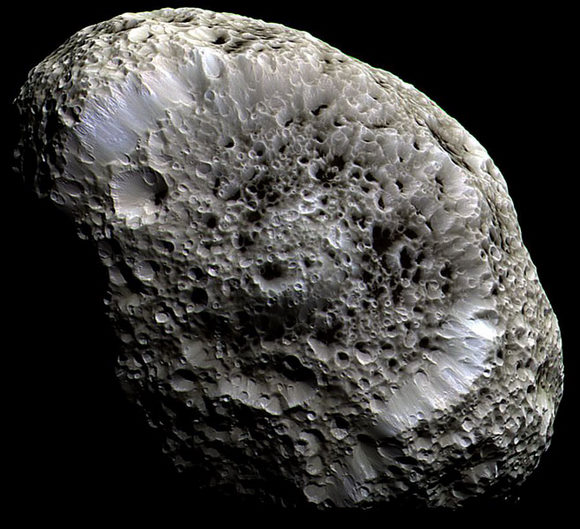It’s Wednesday, so that means its time for another “Where In The Universe” challenge to test your visual knowledge of the cosmos. We’ve been busy searching hither and yon for unusual and unique astronomical images to see how well our readers are acquainted with the various locals across the universe. This week’s image is an unusual looking object. Just what is this thing? Could it be an asteroid, a wierd moon, or something you can find on Earth? Hmmm…… Ponder the image for awhile, and no peeking below before you make a guess. If only I could insert some music here, like the “Think!” theme song from the Jeopardy game show. I’ll have to talk to Fraser about that…
Have you made your guess?
And are you sure?
This is a Cassini image of Saturn’s unusual moon Hyperion. Hyperion is the largest highly irregular (non-spherical) body in the solar system. Scientists believe its very likely that is a fragment of a larger body that was broken by a large impact in the distant past. Is this a coral reef in space?
This sponge-like looking moon is a remarkable world strewn with strange craters and basically a strange surface. At the bottom of most craters lies some type of unknown dark material. Astronomers think the dark material might be only tens of meters thick in some places. Hyperion is about 250 kilometers across, rotates chaotically, and has a density so low that it might be mostly hollow inside — it may house a vast system of caverns. Wouldn’t that be fun to explore!
Or its low density could indicate that it is composed of water ice with only a small amount of rock and considerably porous. It’s very low density also seems to allow impacts to form deeper and sharper craters.
But unlike most of Saturn’s moons, Hyperion has a low albedo (.2 – .3) indicating that it is covered by at least a thin layer of dark material. Cassini data from 2007 indicates that this material is rich in organic molecules. Quite an interesting place, this Hyperion.
How did you do on this week’s challenge?
Original Source: APOD, Nine Planets


It looks like there’s a big and old crater in the middle that got hit some more throughout its lifetime
I had this exact picture as my desktop background a while ago. Try harder!
hyperion
i guessed deimos.
but – spongy, covered in organic goo – this begs to be turned into a giant spacestation (or -ship) somewhen…
Another one that’s just too easy: Hyperion, shot by Cassini.
I should know: I had this exact photo as a desktop background image in my computer for several weeks… 😉
Either these are too easy, or I’m WAY too much of a geek.
Probably the latter.
I guessed “that asteroid with the name I can’t remember that the probe who’s name I can’t remember landed on”.
Oh, well…next time!
Not that easy, I say.
I like this game, though it reminds me that I am an Amateur Amateur Astronomer. I had guessed Phobos.
It’s Hyperion.
I had no idea about this one. I guess it’s one of those you either know (because you’ve seen it before) or you don’t. Darn.
Well, I knew it was one of the Saturnian moons photographed by Cassini because I recall the spongy surface, but with so many moons to pick from… I incorrectly guessed Tethys.
It’s too bad Cassini won’t be going back. The solar system’s largest irregular-shaped body is 40-50% porous. An eccentric orbit out of the ring plane. No tidal lock rotation with Saturn.
Not everything fascinating requires geysers and hydrocarbon lakes.
I too knew it as a moon of Saturn, but I couldn’t recall it’s name. Rats! They say that memory’s the 2nd thing to go.* This one was a tad too easy.
*I cannot remember the 1st thing to go….
It’s Hyperion@Saturn, but instead of playing guessing games, easily answered with a minute of web search, you’d be better promoting discussion on the morphological oddities of what is obviously _not_ an impact formation but is glossed over as one by the planetary scientists. One would need to station a giant pellet gun with multiple careful aims to produce anything close to the radial pattern of craters seen here integrated into the larger structure. Not to mention the degraded cochliod pattern within (look carfully from the near the center of the large formation). Also, and I reference the higher resolution shots available at the Cassini website, the dentritic structures seen radiating inward from some of Hyperion’s (partial) crater rims are very similar to larger structures seen on Mars’ craters (and on Phoebe, and even the Moon). These similarities foster many questions on conventional viewpoints and are better food for thought than playing space Jeapordy.
Bugger. Wrong again.
I thought it was an electron micrograph of some sort of zeolite